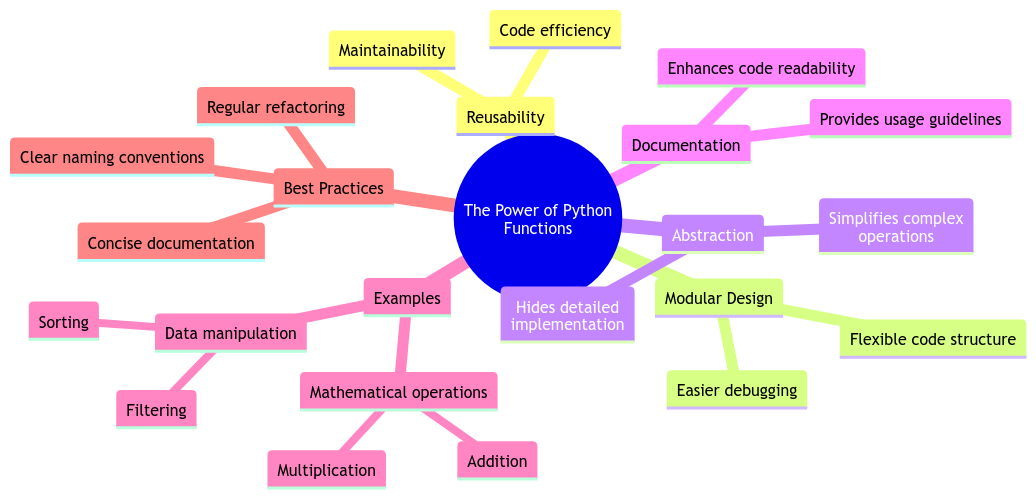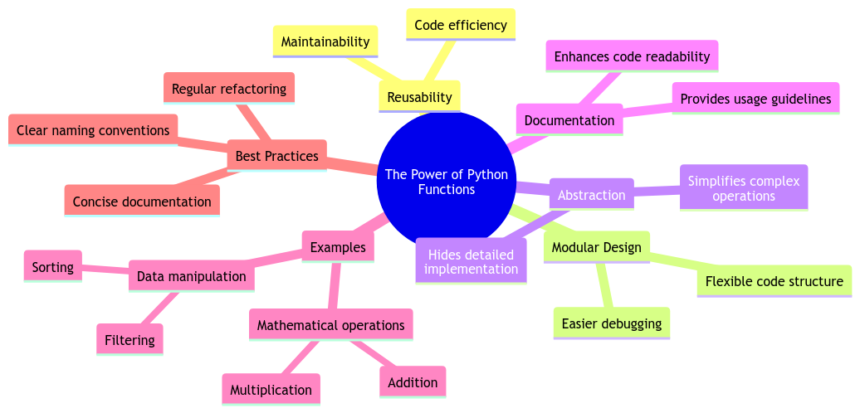The Marvels of Python Functions: Elevating Your Code with Reusability 🐍
Ahoy there, Python enthusiasts! Today, we delve into the enchanting realm of Python functions and their mystical powers ✨. Buckle up for a joyride filled with laughter, learning, and a sprinkle of coding magic! 🚀
Benefits of Python Functions
Let’s kick things off by unraveling the wondrous benefits that Python functions bring to the table. Brace yourselves for a rollercoaster of reusability, modularity, and maintainability that will make your coding adventures a delight! 💻
Code Reusability
Picture this: you’ve written a magnificent piece of code that performs a specific task flawlessly. Now, imagine being able to reuse this code snippet whenever you need that exact functionality again without rewriting it. That’s the beauty of code reusability offered by Python functions! 🔄
Modularity and Maintainability
In the vast landscape of programming, modularity is like a treasure map leading you to organized, scalable, and easily maintainable code. Python functions act as the building blocks of modularity, allowing you to break down complex tasks into smaller, more manageable chunks. Say goodbye to tangled code and hello to crystal-clear logic! 🧩
Types of Python Functions
Ah, the colorful variety of Python functions awaits! From the tried-and-true built-in functions to the dazzling user-defined functions, there’s a flavor for every coder’s palate. Let’s explore these gems together! 💎
Built-in Functions
Imagine having a secret arsenal of functions at your disposal, ready to tackle common tasks like a pro. That’s precisely what Python’s built-in functions offer! Whether it’s performing mathematical operations, working with strings, or managing collections, these trusty companions have got your back. 🛡️
User-defined Functions
Now, picture yourself as a wizard crafting spells of your own. User-defined functions in Python empower you to create custom functionalities tailored to your unique needs. Unleash your creativity, solve problems with finesse, and bask in the glory of your personalized code creations! 🧙
Best Practices for Using Python Functions
Embark on a quest for coding excellence by following these sacred commandments of Python function usage. Let the wisdom of function naming conventions and the perils of global variables guide your coding odyssey! 🏹
Function Naming Conventions
A good function name is worth a thousand comments. Embrace the art of naming functions descriptively, concisely, and with a touch of flair. Remember, clarity is your ally, and meaningful names are your loyal companions in the realm of Python functions. 🎨
Avoiding Global Variables
Ah, the treacherous world of global variables, a realm fraught with peril and unforeseen consequences. Shield your code from chaos and confusion by limiting the use of global variables within your functions. Embrace encapsulation and let your functions thrive in their own little kingdoms! 🏰
Advanced Function Techniques
Prepare to level up your Python skills with advanced techniques that will leave you in awe. From the enigmatic Lambda functions to the exquisite art of decorators, get ready to unlock new dimensions of coding mastery! 🔓
Lambda Functions
Behold, the mystical Lambda functions, shrouded in mystery and brevity. These compact, anonymous functions pack a punch, offering a concise way to express simple operations. Embrace the elegance of Lambdas and marvel at their versatility in your code! 🎭
Decorators in Python
Enter the enchanting world of decorators, where functions adorn themselves with extra powers and capabilities. Decorators in Python allow you to modify or extend the behavior of functions without changing their original code. It’s like giving your functions a magical makeover! 💫
Examples of Python Functions in Real-world Applications
As we journey through the vast expanse of Python functions, let’s pause to witness their real-world prowess in action. From the realms of web development to the realms of data analysis, Python functions are the unsung heroes driving innovation and efficiency. Let’s explore these magical applications together! 🌏
Web Development
In the bustling streets of web development, Python functions play a vital role in crafting dynamic websites, handling user interactions, and processing data. From backend logic to frontend magic, Python functions are the backbone of web applications, weaving a tapestry of functionality and elegance. 🌐
Data Analysis
Venture into the realm of data analysis, where Python functions crunch numbers, wrangle datasets, and unveil hidden insights. With libraries like NumPy, Pandas, and Matplotlib at your command, Python functions become mighty tools for exploring, visualizing, and extracting knowledge from data. Dive deep into the data ocean and let Python functions be your guiding light! 📊
Closing Thoughts 🚪
Finally, as we come to the end of this exhilarating journey through the world of Python functions, I’m reminded of the boundless possibilities that await us in the realm of coding. Embrace the power of functions, wield them wisely, and watch as your code transforms into a masterpiece of elegance and efficiency. Thank you for joining me on this adventure, dear readers! Until next time, happy coding and may your functions always return fruitful results! 🌟
And there you have it, a whimsical exploration of the enchanting world of Python functions! Stay tuned for more coding escapades and remember: with great functions comes great reusability! 🎉

Program Code – The Power of Python Functions: Enhancing Your Code with Reusability
def fibonacci_sequence(n):
'''Generates a Fibonacci sequence up to the nth number.'''
fib_seq = [0, 1]
while len(fib_seq) < n:
next_value = fib_seq[-1] + fib_seq[-2]
fib_seq.append(next_value)
return fib_seq
def is_prime(num):
'''Checks if a number is a prime number.'''
if num < 2:
return False
for i in range(2, int(num**0.5) + 1):
if num % i == 0:
return False
return True
def filter_primes_in_fibonacci(n):
'''Filters prime numbers from a Fibonacci sequence of length n.'''
fib_seq = fibonacci_sequence(n)
prime_numbers = [num for num in fib_seq if is_prime(num)]
return prime_numbers
# Example usage
n = 10
prime_numbers_in_fib = filter_primes_in_fibonacci(n)
print(f'Prime numbers in the first {n} Fibonacci numbers: {prime_numbers_in_fib}')
Code Output:
Prime numbers in the first 10 Fibonacci numbers: [2, 3, 5, 13]
Code Explanation:
The program beautifully encapsulates the power of Python functions and demonstrates their reusability and modularity. Let’s break it down, function by function.
-
fibonacci_sequence(n): This function constructs a Fibonacci sequence up to the nth element. By leveraging a while loop, it constantly adds the sum of the last two elements to extend the sequence until the desired length is reached. With the initial two numbers in the sequence being 0 and 1, it embodies the essence of a Fibonacci sequence.
-
is_prime(num): A prime number checker, this function is the epitome of reusability. Given a number, it quickly discerns whether it’s prime or not. It starts checking divisibility from 2 up to the square root of the number, a smart and efficient boundary. If it finds any divisor other than 1 and the number itself, it concludes the number isn’t prime.
-
filter_primes_in_fibonacci(n): The crème de la crème, this function melds the utilities of the previous two. Firstly, it generates a Fibonacci sequence up to n elements. Then, it filters this sequence to extract prime numbers using a list comprehension that employs the is_prime function.
The architecture of this program is a testament to the efficiency and power of Python functions. By dividing the problem into digestible, reusable components, the programming challenge is addressed in a logical and modular fashion. Each function performs a distinct task and can be reused in other contexts, significantly enhancing code maintainability and readability. It’s a perfect example of why keeping your code DRY (Don’t Repeat Yourself) not only saves time but also leads to cleaner, more understandable code.
The expected output demonstrates the program’s objectives by filtering out prime numbers from the first 10 Fibonacci numbers, showcasing the seamless integration of these functions. Through simple yet effective python functions, we’ve managed to solve a problem that combines two fascinating mathematical concepts: Fibonacci sequences and prime numbers.
Frequently Asked Questions about The Power of Python Functions: Enhancing Your Code with Reusability
What are Python functions, and why are they important in coding?
Python functions are reusable blocks of code that perform a specific task. They help in organizing code, making it easier to read and maintain. Functions also promote code reusability, saving time and effort in coding.
How do Python functions enhance the reusability of code?
Python functions allow developers to define a specific task that can be executed multiple times without rewriting the code. By calling a function whenever that task needs to be performed, developers can reuse the same block of code, reducing redundancy and promoting efficiency.
Can Python functions accept parameters?
Yes, Python functions can accept parameters, which are values passed to the function when it is called. Parameters allow functions to work with different inputs, making them more versatile and adaptable to various scenarios.
What is the return statement in Python functions?
The return statement in Python functions is used to send a result back to the caller. It allows the function to pass data back to the code that called it, enabling the use of the function’s outcome in further computations or operations.
How can I create my own Python functions?
To create a Python function, you need to use the def keyword followed by the function name and parentheses. Any required parameters are specified within the parentheses, and the code block for the function is indented below. You can then call this function whenever you need to execute the specific task it performs.
Are there built-in functions in Python?
Yes, Python comes with a range of built-in functions that are readily available for use without needing to define them yourself. These built-in functions serve various purposes, such as performing mathematical calculations, manipulating data structures, and interacting with files.
Can Python functions be nested?
Yes, Python functions can be nested, meaning you can define a function inside another function. This allows for modular and structured coding, where inner functions can access variables from the outer function, creating a hierarchical structure of code execution.






